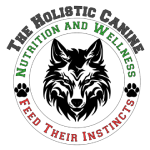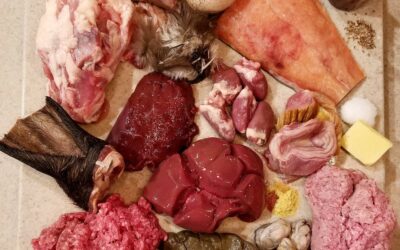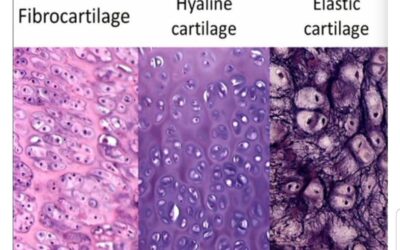The Incredible Raw Meaty Bones
Providing your dog with a nutrition plan that cultivates optimal health may not require a PhD or a medical degree, but it does require a good bit of knowledge and appreciation of biology and nutrition science. When we carefully consider the word balance, we must understand it in the correct perspective. As I wrote in Part I, balance is created by and through a biological system (the body) based on physiological need. We cannot create balance. Balance is an internal process. We can provide a diet that is labeled “balanced” by the pet food industry standards, but I believe this is insufficient. What we must really focus our attention on is preventing an internal imbalance from occurring. Imbalance within the body can and does occur from an insufficient and poorly planned nutrition strategy if the diet is consistently and/or severely lacking in the essential nutrient-containing ingredients that your dog requires to cultivate health and maintain internal homeostasis.
Based upon my research and years of experience, I believe that a lack of a critical component in the modern canine diet is a reason why many pet parents are experiencing issues and conditions in their dogs despite carefully creating and providing a “balanced” diet. Dogs need bones. Bone is a food that I believe is not an option. Providing a substitute for bone creates a whole host of nutrient insufficiency. Most pet parents who are using their dog’s NRC, FEDIAF, or AAFCO nutrient requirements are on a mission to fulfill every one of the required nutrients. When the focus is on nutrient fulfillment rather than on balance and species-appropriate nutrition, sourcing food ingredients becomes a major problem. Fulfilling nutrients with ingredients that are not species-appropriate to hypothetically supply a nutrient or nutrients is to me taking a dangerous gamble with your pet’s health. Variety is essential, but reaching beyond species-appropriate foods is not the answer to creating internal harmony. Your dog needs to be able to easily and efficiently digest food ingredients in order to unlock the energy and nutritional building blocks contained within. If digestion is hampered or insufficient, your nutrition plan will never cultivate optimal health. If your dog’s intestinal microbiome is weak and not nurtured via species-appropriate foods, health will not be on his future radar. And if your dog’s intestinal walls are irritated and inflamed, nutrient absorption is insufficient to create the health your dog requires for longevity and a pain-free existence. This is what creates internal imbalance.
Remember what Dr. Jeannie wrote pertaining to diet? “Balance is nothing but an insufficient human term, a vague concept that pet food companies employ to make people buy processed foods for their pets.” It is a scare tactic. Your focus should be on providing a variety of species-appropriate foods in the correct proportions.
If we look at this from a biological point of view, it would look like this. Animals require food first and foremost to supply energy for metabolism and to maintain internal homeostasis. Homeostasis is balance. Internal balance (homeostasis) is your dog’s ability to maintain a stable internal environment despite changes to his external environment. This can include changes in diet, atmosphere, stressors, air quality, etc. Further, in order for your dog (and you) to build cellular material and tissues, he must receive organic molecules that can only be obtained from food. Your dog requires nitrogen, carbon, and fat. (Keep in mind that dogs have no use or need for carbohydrates.) Protein catabolism is your dog’s source of nitrogen and carbon. Proteins are made up of linked amino acids that when broken down via digestion, provide the building materials necessary for cellular function. Both nitrogen and carbon are the major components for the creation of nucleotides, nucleic acid, new proteins, cells, and all body tissues. Fat is the major source of energy (along with excess protein via gluconeogenesis) and is needed for hormone production and for the absorption of fat soluble vitamins, among numerous other functions. The species-appropriate sources of protein and fat are meat and offal. Nothing more needs to be fed to a dog to supply these essential requirements.
Your dog also has a need for essential micronutrients that he cannot synthesize. Essential minerals, vitamins, and fatty acids can all be adequately obtained from species-appropriate foods. And yet, a major problem exists when focus goes to fulfilling pet food industry nutrient standards rather than providing an appropriate fresh raw diet complete with variety. Nutrient fulfillment becomes the game and common sense goes out the window. Please do not misunderstand me. Species-appropriate foods are thus called species-appropriate because the animal is perfectly able to thoroughly digest them to provide all the nutrients the animal requires to cultivate optimal health. Pet food industry nutrient standards are based on:
- test studies using laboratory animals in atypical and unnatural settings [1]
- adulterated processed food void of all nutrients
- sprayed-on synthetic vitamin isolates and inorganic industrial chemicals added to adulterated processed pet foods
A species-appropriate raw food diet has nothing in common with foods produced by the commercial pet food industry. It is an illogical comparison.
Let’s go back to bone. I have thus far pointed out that dogs require meat and offal. The only other missing component is raw meaty bones. These three components can adequately supply all the nutrients a dog requires to cultivate radiant health. Recalling from Part I, I listed all the nutrients supplied in bone. Why not review it yet again?!
Hard bone contains:
- calcium
- phosphorus
- magnesium
- potassium
- sodium
- chloride
- sulfur
- silica
Marrow contains [2]:
- calcium
- iron
- zinc
- manganese
- selenium
- vitamin A
- vitamin E
- vitamin K
- B vitamins (B1, B2, B5, B7, B12)
- Boron
- fatty acids
The connective tissue is a major source of:
- glucosamine
- chondroitin
Meat contains a wealth of vitamins and minerals. Organs contain even more. In fact, I consider organs a dog’s multi-vitamin/mineral. Offal is so rich in nutrients that we provide them in smaller amounts in a raw food diet [3]. With so many nutrients already to be found in meat and offal, bones provide the topping-off, if you will, of minerals and vitamins. Bones are the major source of minerals in a raw fed dog’s diet. Providing raw meaty bones as half of your dog’s diet assures an adequate amount of easily assimilated nutrients are being supplied. Yet, knowing what bones to offer is another key to creating balance.
If you are feeding whole prey, then your dog is receiving absolutely everything that he needs. Assuming most of us cannot supply whole prey at every meal, or even at all, knowing which bones to provide is critical to receiving an ideal amount of nutrients. It is best that your dog receives bone with ample marrow as often as you are able.
Marrow is the soft fatty tissue found inside bone. There are two types of marrow: yellow and red. All bone marrow creates stem cells which are responsible for producing white blood cells, red blood cells, and platelets. The function of these cells is to fight infections, carry oxygen throughout the body, and clot blood. Yellow bone marrow is found in the long bones of the legs while red marrow is found in ribs, hips, the skull, spinal vertebrae, shoulder blades, and the ends of long bones. Marrow is a source of amino acids, fat, minerals, and vitamins. Your dog must be supplied with both yellow and red marrow. Be sure to offer your dog all types of bones to ensure that a good range and percentage of marrow is being provided. For yellow marrow, I purchase “marrow” bones from the butcher with the marrow clearly accessible.
Thanks to the research of the Weston A. Price Foundation, we know that bone marrow is a powerful anti-inflammatory, boosts the immune system, and helps with weight management. A Swedish Oncologist, Dr. Astrid Brohult, gave her leukemia patients bone marrow broth. As a result, several of her patients had their white blood cell counts return to normal. Years later, Dr. Brohult’s biochemist husband discovered the alkyglycerol (AKG) compounds in bone marrow responsible for while blood cell production. Alkyglycerols are immune-boosting lipids now being used in cancer therapy that can also be found in human breast milk and cow’s milk. If this isn’t enough to excite you, bone marrow helps to seal the stomach lining, reduces discomfort and pain associated with intestinal inflammation, and improves overall gut health [4]. Even more, a University of Michigan study has shown significant amounts of the hormone adiponectin within marrow’s fat tissue. Adiponectin supports insulin sensitivity, breaks down fat, protects the heart, and decreases diabetes risk and obesity-associated cancer [5].
While these studies on bone marrow consumption are human studies, imagine the benefit to dogs. After all, bone marrow is a species-appropriate food perfectly suited to cultivate optimal health in canines. So, let’s now simply consider the nutrient value. As you can see from the nutrient list above, bone marrow is exceptionally nutrient-dense. While meat alone contains a wealth of nutrients, marrow is often richer in vitamins and minerals dependent upon which bone and from what animal. If you take a look at the reference provided for the bone marrow nutrients, you will note that the marrow is rich in Vitamin E, a nutrient that is nearly impossible to source from meat and organs alone. Couple this with the connective tissues rich in glucosamine and chondroitin and your dog will build and maintain a strong, resilient and disease-free body throughout the entirety of his life.
The most popular current recommendation for feeding bone comes from the 80/10/10 ratio which states to feed bone at approximately 10% of the diet. The bone percentage of whole prey, however, is slightly to significantly higher than 10%. The original recommendation for feeding a raw meaty bone (RMB) diet was to feed half to 60% of the diet comprising of RMBs. That equates to a range of 10% to 25% bone, marrow, and connective tissues with the remaining foods consisting of meat and offal. This is especially crucial for growing puppies. Dr. Ian Billinghurt, a leading authority on raw feeding and the originator of the BARF diet, recommends puppies receive RMBs with 50% bone, “Approximate biological balance is achieved so long as meat alone is not the principal dietary component. That job must be left to the raw meaty bones (RMBs). When a young and growing dog eats RMBs, if the bone to meat ratio of those RMBs is around 1:1, then the balance of calcium to phosphorus is appropriate for bone mineralization and formation.”
Balance is an ambiguous and even complex word that can take on many faces, meanings, and understandings. In the nutrition science realm, balance has always meant a wide variety of several types of nutrient-rich foods. If your desire is to provide a balanced diet, then offer your dog nutrient-rich species-appropriate foods that provide far more than just a nutrient that you are trying to source to fulfill a standard. In my practice I recommend feeding highest nutrient per bite ratio foods. These include foods that cover a broad spectrum of minerals, vitamins, enzymes, factors, co-factors, antioxidants, beneficial lipids, active constituents, and more. Bones fall under this category.
Nutrients are vital, but so is providing the correct foods that supply a plethora of vital nutrients and components for the cultivation of optimal health.
©2019 Kimberly Lloyd, PhD, BCHHP, Cert Raw Dog Food Nutritionist
[1] If you are against animal testing, you might want to look into the early nutrient studies completed on caged dogs which were starved of nutrients in order to discover minimum requirements to prevent death. If this is not cruel enough, modern pet food testing laboratories are filled with lab animals bred in the lab to complete a lifetime of food trials. Sadly, they live their entire life in a lab and are disposed of when they die. Supporting commercial dog food is an ethical issue as well as being a poor nutrition choice for your dog. Visit https://www.crueltyfreekitty.com/pets/cruelty-free-pet-food/ & https://truthaboutpetfood.com/pet-food-animal-testing/ for more information.
[2] https://www.ncbi.nlm.nih.gov/pmc/articles/PMC3417664
[3] Secreting organs such as liver, kidney, and pancreas are supplied at approximately 10% of the diet. Muscle organs such as heart, lungs, and gizzard are supplied at approximately 15% of the diet. Offal can make up a total of approximately 25% of the diet.
[4] Results seen in patients of functional medical doctor, Dr. Auer. https://www.doctorauer.com/
[5] https://www.sciencedaily.com/releases/2014/07/140703125216.htm



